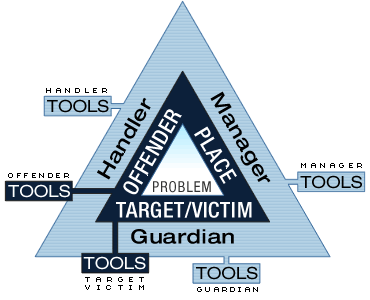PAM was developed to assist police problem solving through the asking of specific questions. The questions come from research into a set of powerful theories within the field of Environmental Criminology – particularly Routine Activity Theory, Situational Crime Prevention, and Crime Pattern Theory.
 These
theories have been applied to policing problems for some time. Perhaps
the most visible application is the use of the problem analysis triangle
(or crime triangle) that comes from Routine
Activity Theory. (link opens new window)
These
theories have been applied to policing problems for some time. Perhaps
the most visible application is the use of the problem analysis triangle
(or crime triangle) that comes from Routine
Activity Theory. (link opens new window)
The basic idea behind PAM is that asking good specific questions is the first step toward understanding a problem. The answers to these questions should lead to possible responses to the problem. So that is how PAM is organized. It asks you questions. Based on your answers, it suggests types of responses that might be useful.
So PAM is designed to guide analysis and provide a bridge from analysis to response.
Because PAM is a general-purpose tool – designed to be applied for a wide range of problems -- it will suggest categories of responses. You will have to look at the recommendations and determine how they apply to your particular circumstances and how you could implement them.
PAM is only a part of problem analysis. You are the other part, and the most important part. You contribute four important things to problem solving.
We hope you find PAM useful. We appreciate any comments you might have on how we can improve it, so please complete the evaluation form.
